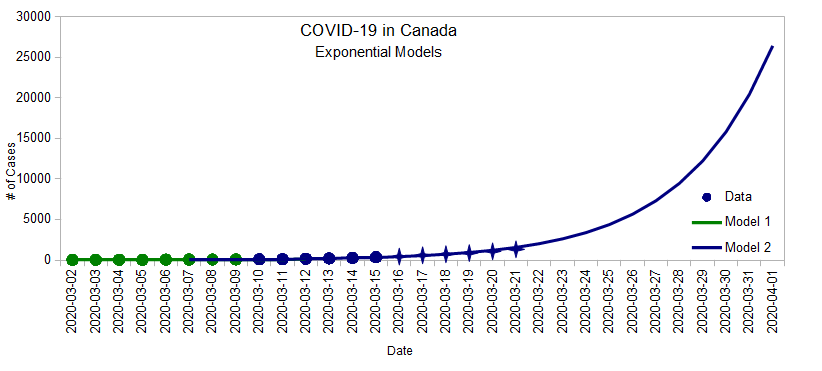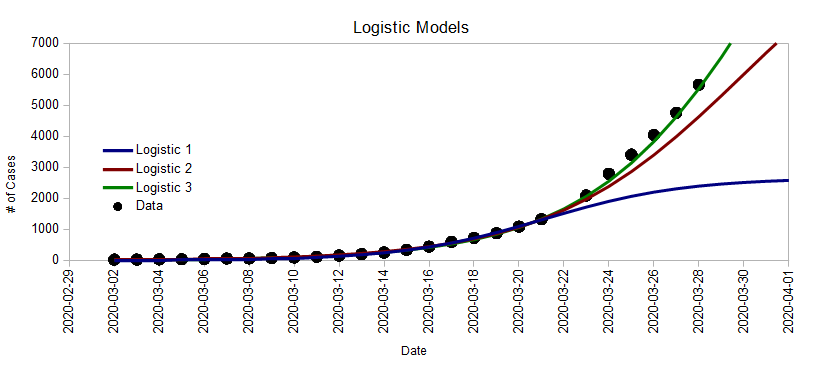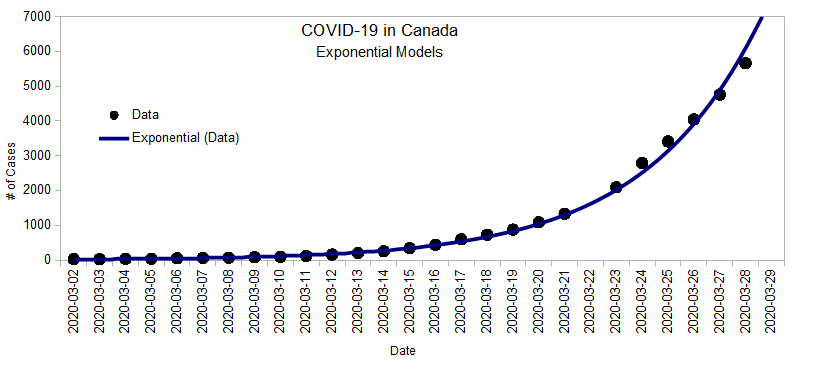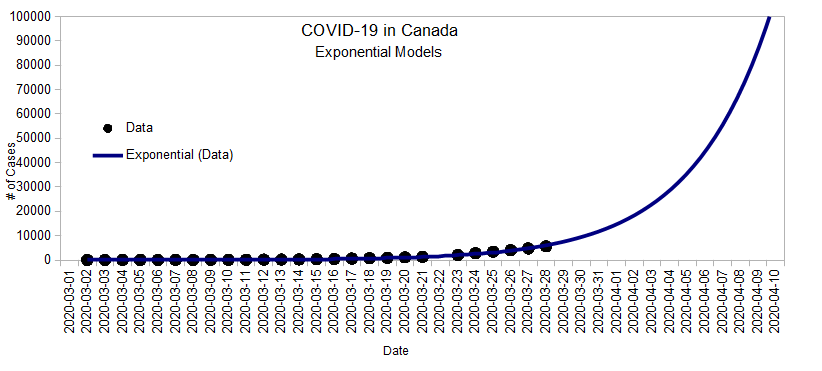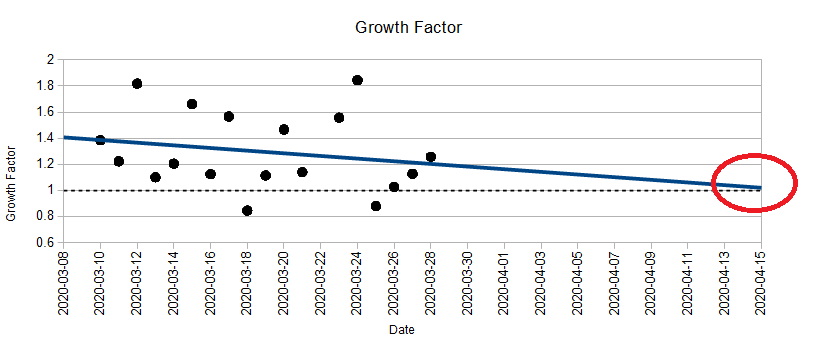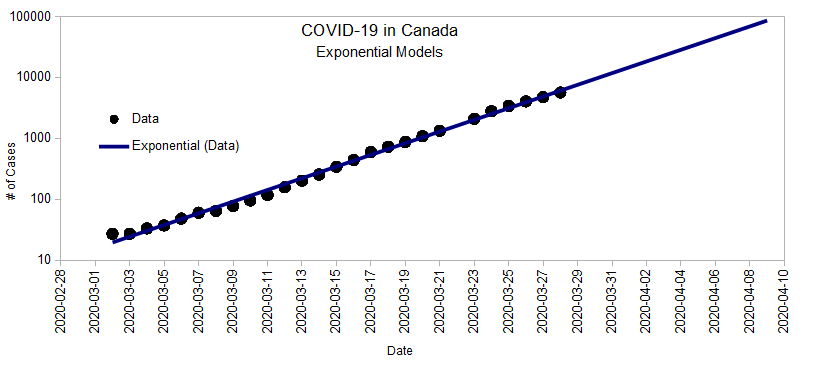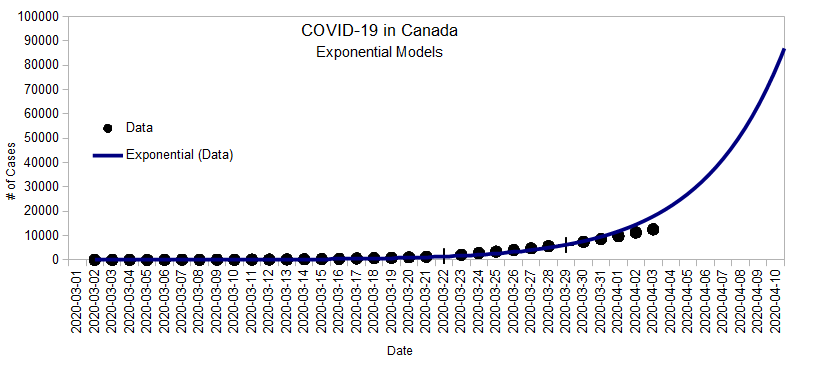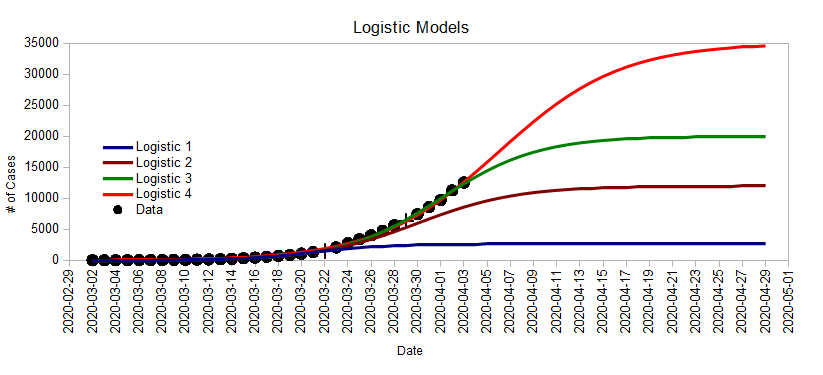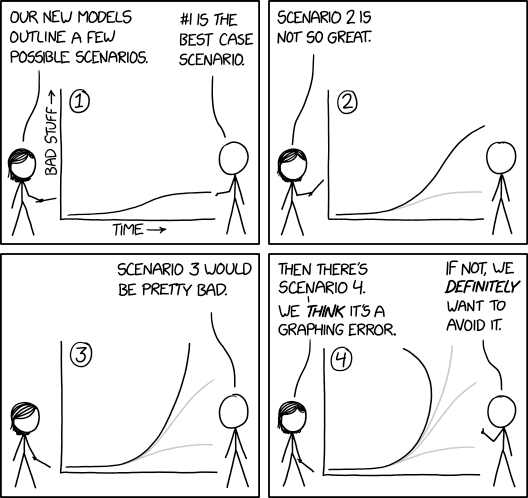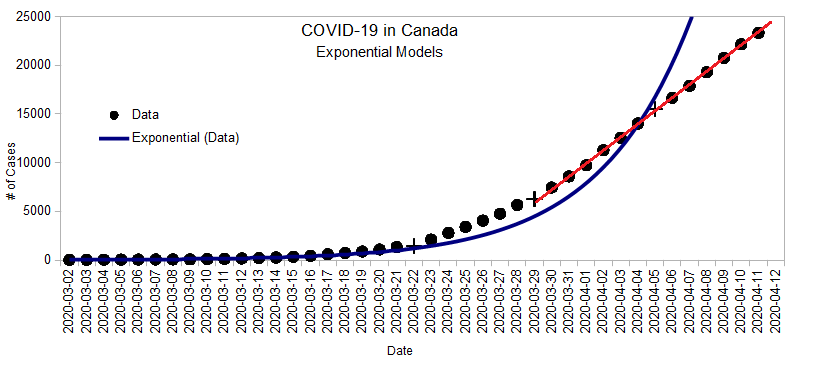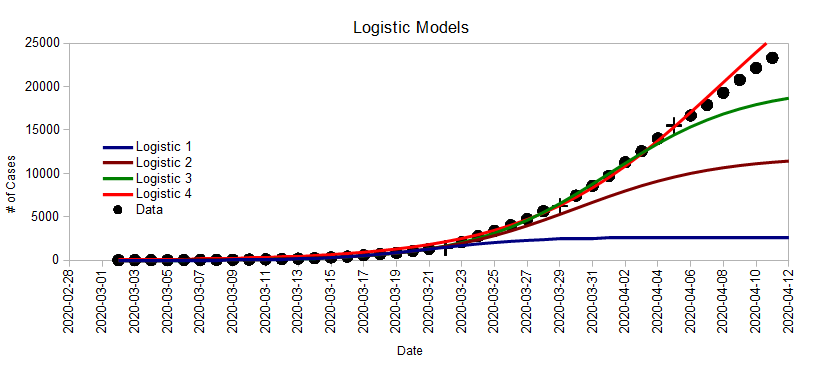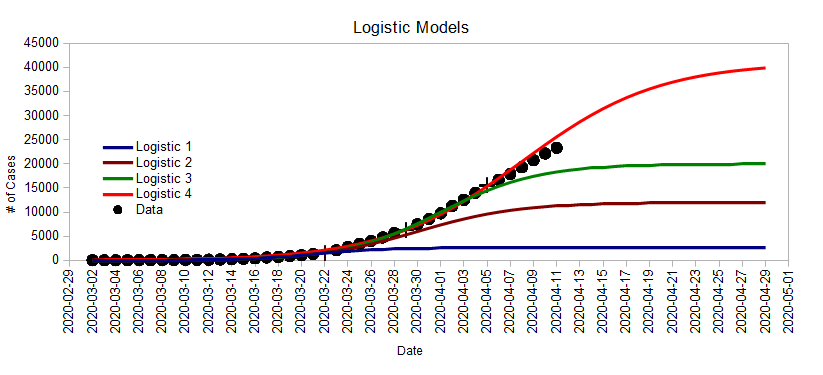This is an old revision of the document!
Table of Contents
COVID-19 Spread (Part II)
- I'm not an epidemiologist, doctor, or any kind of expert on the subject. I just look at the numbers.
- This was originally written on Sunday March 22nd. Since then, I've updated the numbers and added updates at the end of the post.
In Part I, I built an exponential model using data between March 2 and March 15, then continued to add daily numbers to see how that model tracked:
Initially, the number of cases doubled every 2.7 days, predicting almost 1600 cases by the end of Saturday March 21, but since Thursday, the infection rate seems to have slowed down a bit and we got about 1331 cases instead. This deviation from the exponential model is what I explore below.
Growth Factor
There's a ratio involving three data points that's useful to track how “fast” the exponential grows. It's easier to explain with an example, so suppose we had three days like this:
| Day | # of Cases | New Cases | Growth Factor |
|---|---|---|---|
| Day1 | 100 | ||
| Day2 | 110 | 10 | |
| Day3 | 130 | 20 | 2 |
To calculate the growth factor:
- Take the number of new cases from one day to the next (10 new cases from Day 1 to Day 2, 20 new cases from Day 2 to Day 3)
- Then, take the ratio between new cases (20 ÷ 10 = 2)
- If the growth factor > 1, the number of new cases is itself increasing each day, which means we are still in the exponential phase.
- If the growth factor = 1, then the number of cases is growing at a constant rate (same amount each day). This is the middle of the Logistic Curve (more on that soon).
- If the growth factor < 1, then the infection rate is levelling off.
- If the growth factor = 0, then the epidemic is over.
Here are the number of cases in Canada with the calculated growth factors:
March
| Date | # of Cases | New Cases | Growth Factor |
|---|---|---|---|
| 2020-03-01 | ? | ||
| 2020-03-02 | 27 | ||
| 2020-03-03 | 27 | 0 | |
| 2020-03-04 | 33 | 6 | |
| 2020-03-05 | 37 | 4 | 0.67 |
| 2020-03-06 | 48 | 11 | 2.75 |
| 2020-03-07 | 60 | 12 | 1.09 |
| 2020-03-08 | 64 | 4 | 0.33 |
| 2020-03-09 | 77 | 14 | 3.25 |
| 2020-03-10 | 95 | 18 | 1.38 |
| 2020-03-11 | 117 | 22 | 1.22 |
| 2020-03-12 | 157 | 40 | 1.82 |
| 2020-03-13 | 201 | 44 | 1.10 |
| 2020-03-14 | 254 | 53 | 1.20 |
| 2020-03-15 | 342 | 88 | 1.66 |
| 2020-03-16 | 441 | 99 | 1.33 |
| Date | # of Cases | New Cases | Growth Factor |
|---|---|---|---|
| 2020-03-17 | 596 | 155 | 1.57 |
| 2020-03-18 | 727 | 131 | 0.85 |
| 2020-03-19 | 873 | 146 | 1.11 |
| 2020-03-20 | 1087 | 214 | 1.47 |
| 2020-03-21 | 1331 | 244 | 1.14 |
| 2020-03-22 | BC did not report its numbers on March 22. | ||
| 2020-03-23 | 2091 | 380 | 1.56 |
| 2020-03-24 | 2792 | 701 | 1.84 |
| 2020-03-25 | 3409 | 617 | 0.88 |
| 2020-03-26 | 4043 | 634 | 1.03 |
| 2020-03-27 | 4757 | 714 | 1.13 |
| 2020-03-28 | 5655 | 898 | 1.26 |
| 2020-03-29 | BC did not report its numbers on March 29. | ||
| 2020-03-30 | 7448 | 897 | 1.00 |
| 2020-03-31 | 8591 | 1143 | 1.27 |
April
| Date | # of Cases | New Cases | Growth Factor |
|---|---|---|---|
| 2020-04-01 | 9730 | 1139 | 1.00 |
| 2020-04-02 | 11283 | 1553 | 1.36 |
| 2020-04-03 | 12549 | 1266 | 0.82 |
| 2020-04-04 | 14018 | 1469 | 1.16 |
| 2020-04-05 | BC did not report its numbers on April 5. | ||
| 2020-04-06 | 16667 | 1325 | 0.90 |
| 2020-04-07 | 17897 | 1230 | 0.93 |
| 2020-04-08 | 19290 | 1393 | 1.13 |
| 2020-04-09 | 20765 | 1475 | 1.06 |
| 2020-04-10 | 22148 | 1383 | 0.94 |
| 2020-04-11 | 23318 | 1170 | 0.85 |
| Date | # of Cases | New Cases | Growth Factor |
|---|
There's a lot of variation in the growth factor because real life is messy. It's also worth keeping in mind that the numbers we see are contingent on how much testing we do. It's easy to imagine that testing labs are lagging a few days behind and that they'll sometimes be able to report more results one day and less the next.
We don't have an accurate picture of the world here so it's hard to make any kind of hard predictions. Never-the-less, as of March 21, there seemed to be a loosely decreasing pattern:

Overall, the growth factor is mostly above 1 (in the exponential phase), but it looks like we might be on track to reach 1 by the end of the month (end of exponential phase). If that's the case, and if we continue to implement measures to slow the down the spread, then we'll be in a better position to estimate the final outcome by the end of the month. Here's why.
The Logistic Curve
In Part I, we saw that very different Logistic Curves can fit the current data, and that there's really no way of knowing which path we're on yet. Here they are again:
- Logistic 1 was the very best case scenario (as of March 22) where the total number will be double of what it is today. This assumes that the growth factor reached 1 yesterday (March 21), which it hasn't. But we're way passed that now.
- Logistic 2 is an optimistic scenario where the total number reaches 12,000 and the growth factor reaches 1 on March 30st.
- Logistic 3 is a very likely scenario where the total number reaches 20,000 and the growth factor reaches 1 on April 1st. This is not a worst case scenario. Things could be much worse (look at Italy).
Here are a few things to know about the Logistic Curve. In the middle:
- The curve is flat like a straight line, which indicates that the growth rate is constant.
- This means that the growth factor is 1 (by definition)
- It also happens that this is the halfway point in terms of total number of cases.
So once we reach that point, we'll be able to get a better estimate of where we'll end up. Until then, things are still very much in the air.
March 28th Update
A lot happened this week:
- BC seems to be dropping the ball on testing. Their reported numbers are proportionally much lower than Quebec and Ontario and the messaging is that we might finally be “flattening the curve”. However, it could simply be that we are not testing enough and are way behind on reporting results. On a personal note, I finally got my result yesterday (negative): three weeks after getting tested!
- Quebec went the opposite way, increasing their testing and finding a lot more cases.
Over all, it looks like we are back on the exponential curve with an overall doubling time of 3.1 days:
The Growth Factor also seems to support this as it is barely decreasing. Again, a Growth Factor of 1 means that we could be at the half-way mark. As long as it's above 1, we don't know...
Over a week ago, back when we only had 342 cases, the model (at the time) predicted we were about two weeks behind Italy (which had 26,000 then).
The updated model (doubling every 3.1 days) predicts that we are about 12 days behind Italy (with now has over 92,000 cases). Whatever we have been doing is either not working or we are not seeing the effects yet.
According to the CBC from March 25th:
“Dix and provincial health officer Dr. Bonnie Henry both said they are optimistic B.C. isn't following the same path as countries like Italy that have seen their healthcare systems overwhelmed by huge spikes in hospitalizations and deaths.”
Country-wide, the numbers disagree. We have about two weeks behind Italy since the beginning of March. Province-wide, the numbers do look better, but it could well be because we are not testing as much as other provinces like Quebec and Ontario. There are no reasons to be optimistic about being on a different path.
Here's a different way to look at the exponential curve when the number of cases is presented as a multiple of 10 on the vertical axis (called a logarithmic scale):
If we stay on that line, we'll reach 100,000 cases by April 10th!
Cleaning Groceries
Here's a video shared by the Mid Island Radio Group:
Other Models
Compartmental Models are popular such as the SEIR (Susceptible, Exposed, Infected, Recovered) Model. https://en.wikipedia.org/wiki/Compartmental_models_in_epidemiology#The_SEIR_model
Kaggle has a modelling competition which has some good data sets. You need to use a Google ID to access this (I think since Google brought Kaggle a few years ago). https://www.kaggle.com/c/covid19-global-forecasting-week-3
April 3rd Update
Hard to believe that a month ago, there was only 27 reported cases in Canada (compared to 12,549 cases today). It looks like BC is still vastly under testing so the actual numbers are probably much higher than they appear to be. However, looking at what's reported, it looks like we could be nearing the halfway mark:
For the last week, the infection rate seems to be flatter than it has been.
With the same physical distancing measures in place, it looks like we could see between 20,000 and 35,000 cases. But the future is still highly unpredictable precisely because it is up to us.
I've also said a few times that BC is way behind on testing and that the numbers we see are vast underestimates. This CBC article, Why COVID-19 testing varies so much across Canada, dives into this issue somewhat. It would be nice if, in addition to the number of new cases reported, each province also had to report the number of tests that were analyzed that day. It would give us a much better sense of how everyone is doing. For example, if Quebec is testing 10 times more than BC is, it's not surprising they are finding more cases. That's just an example because I don't know how much more they are testing. If anyone finds that information somewhere, please share it here!
On a lighter note, xkcd puts this whole post into context:
“Remember, models aren't for you telling facts, they're for exploring dynamics.
This model apparently explores time travel.”
April 12th Update
It's been over a week since the last update and according to the numbers, it looks like we are off the Exponential curve and into the linear growth middle section of the Logistic curve:
The calculated Growth Factor also seems to have dipped below 1:
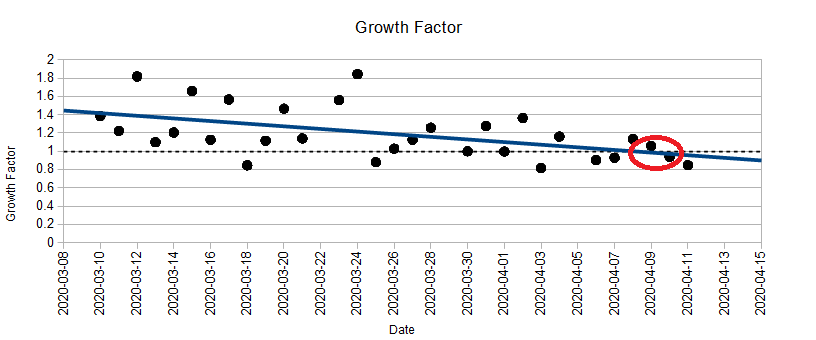
Again, recall that:
- If the growth factor > 1, the number of new cases is itself increasing each day, which means we are still in the exponential phase.
- If the growth factor = 1, then the number of cases is growing at a constant rate (same amount each day). This is the middle of the Logistic Curve (more on that soon).
- If the growth factor < 1, then the infection rate is levelling off.
- If the growth factor = 0, then the epidemic is over.
I am still very skeptical that these numbers are an accurate description of the current situation however. I feel like I have to explain an apparent contradiction here:
Why is it that back in March I seemed to trust the numbers when I was saying that the virus was spreading exponentially, but now I seem to distrust the numbers when they say that the infection rate is finally levelling off? Am I just a pessimist regardless of what the evidence says?
The quick answer is no. The way evidence works is not symmetrical. Imagine you think there's a ball hidden in the room:
- If you find it, you can, with 100% certainty, say that there was a ball in the room.
- If you don't find it, you can't say anything with 100% certainty. Maybe there isn't one, but maybe there is and you just didn't find it.
So back in March, the reported cases grew exponentially, so I could say with 100% certainty that the virus spreading exponentially. Now, the reported cases seem to be growing linearly (the curve is flattening). There are two possible explanations for this:
- The infection is actually flattening out (I really hope and wish this is the case).
- The amount of testing we do is insufficient and we are not recording the actual spread of the virus (I suspect this is the case).



